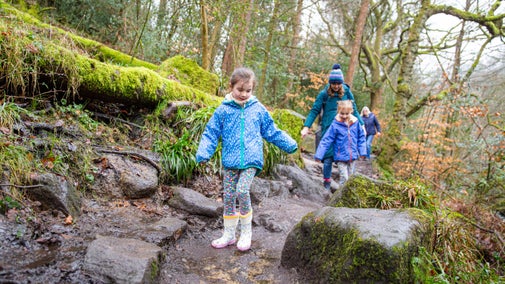
Donate
Everyone needs nature, now more than ever. Donate today and you could help people and nature to thrive at the places we care for.

Hardcastle Crags is an important place for a wide range of species and it’s vital to manage the woodland to improve the quality of the habitat. Read on to find out about our work at Hardcastle Crags and Gibson Mill, including current priorities and ongoing projects.
Hardcastle Crags has a ten-year management plan outlining the work needed to keep the woodland thriving. The top three priorities are to:
Other aims include maintaining a visually beautiful site, protecting the site’s natural and cultural heritage, contributing to the local economy and managing health and safety across Hardcastle Crags.
Read the woodland management plan
To increase opportunities for local wildlife, the team plan to increase light levels to the woodland floor through thinning and selective felling. This is essential for the regeneration of new native trees and wildflowers. Where regeneration does not occur naturally, new trees will be planted.
Both standing and fallen deadwood will be created, providing an important habitat for a host of species, from fungi to beetles and birds. In addition, work will take place to remove invasive species, in particular Himalayan balsam. These plants stop native flora from growing and prevent tree regeneration.

Right now, there are areas of Hardcastle Crags densely populated by beech trees. These block light from reaching the woodland floor and stop plants and flowers from growing underneath them.
With no ground plants, the rainwater flows quickly to the streams taking leaf litter and soil with it. This in turn causes blockages which increases the risk of flooding in Hebden Bridge and the local area.
Our Slow The Flow projects is implementing natural flood control methods, such as building leaky dams, to protect areas further downstream.
Find out more about the Slow The Flow project
Building on the work already happening at Hardcastle Crags, heat and electricity will be produced through sustainable sources. These include hydroelectric power produced by the Hebden Water and heating provided from on-site firewood.
Tree thinning will also take place, to help promote the growth of new trees and protect soils from erosion.
With 140 acres of unspoilt woodlands and more than 15 miles of footpaths to look after, there's plenty to keep our team busy. Our rangers are always busy repairing fences, paths, signposts and picnic benches.

Gibson Mill is a beautiful historic building, but it needs care and attention. Built in around 1800, it was one of the UK’s first mills to power the Industrial Revolution, driven by a water wheel to produce cotton cloth. Restoration began in 2005. Work included the restoration and reinstatement of the cotton mill’s original 1926 Francis hydro turbine, the installation of a smaller Crossflow hydro turbine for use when water levels are low, and the addition of a solar photovoltaic system, as well as a battery storage system. We recently updated the solar photovoltaic panels on the mill’s roof to increase capacity, with future plans to refurbish the Francis turbine to ensure reliable renewable energy for years to come.
Today, it's the first renewable place looked after by the National Trust that’s off the grid. This means we're not connected to mains power, water or the sewage network.
Along with the day-to-day maintenace that comes with a building of this age, our team also maintain the special features that allow us to be off the grid. This includes lighting the wood-fuelled boiler every day to power the hot water for the Weaving Shed Café, maintaining our battery system and looking after our special composting toilets.
We wanted Gibson Mill to be totally self-sufficient, without bringing in mains services. It had to rely on the natural resources found on the site, including using water and daylight to power heating and lighting, and spring water for washing and drinking.
At the same time, we needed to preserve the historic quality of this nineteenth-century mill and former entertainment emporium, whilst respecting its spirit.
Today, the only ‘mains’ connection with the outside world is the phone line, making the mill unique in the UK.
A renewable energy system was installed by leading renewable energy company Dulas Ltd. We used local labour and sought to obtain all materials from sustainable, local sources.
The mill’s roof-mounted solar panels and water turbines, which generate energy using the river, provide almost all the power for the mill and the café.
A boiler that uses sustainably-sourced logs from the surrounding woodland heats spring water for the café. The quality is monitored and provides water for drinking, washing up and the toilets, with the help of a simple filtering system.
Resident tiger worms are used to compost waste from the toilets. These are dry composting lavatories, which treat human waste so that it can be recycled as fertiliser for use on site.
Between them, these systems allow us to operate without a connection to the outside world for energy or water.
With your ongoing support, we're able to continue our vital conservation work. Thank you for helping to protect these special places.

Everyone needs nature, now more than ever. Donate today and you could help people and nature to thrive at the places we care for.
Discover how the National Trust has put Calderdale on the map with its Grassland Fungi Project.
With 15 miles of footpaths to explore in the beautiful Yorkshire countryside, there's lots to discover on a walk at Hardcastle Crags.

Learn about the history and evolution of the landscape at Hardcastle Crags and Gibson Mill, including its industrial heritage and the mill’s time as an entertainment emporium.

Read about our strategy, which focuses on restoring nature, ending unequal access and inspiring more people.

We believe that nature, beauty and history are for everyone. That’s why we’re supporting wildlife, protecting historic sites and more. Find out about our work.
